- Home
- Steve Rasnic Tem
Ugly Behavior Page 3
Ugly Behavior Read online
Page 3
“I didn’t want to worry you. But given his character, I thought he might stick around, plot revenge. Cowards, they always seek revenge.”
“I wish you had told me.”
“Maybe, maybe I should have. But I searched those hills, and beyond, thoroughly. I can’t figure out how I missed him.”
It was his way of taking responsibility, of expressing his sorrow, I knew. But it aggravated me how he’d turned this terrible thing that had happened to me into a puzzle that not only he hadn’t solved, but that he might have prevented. My dad had god forbid made a mistake. “It’s over,” I said. “It’s past. Do they know where he his now? Did you call Mom?”
He blanched. “The police called her, warned her. She should have come to visit you. I don’t want to see her, of course, but she’s your mother.”
“I don’t want to see her, either, Dad. I just thought she should be warned, in case he shows up at her house.”
“They alerted the local police out there, and the state police in between. They’re pretty sure, they think, he’s left the state.”
“That’s good.” We sat there in silence, neither one of us comfortable talking about it, but wanting to behave normally, and not knowing what normal behavior really meant. “Your paintings,” I began, because I’d been thinking about them. To be honest, it was the first thing I thought of when I regained consciousness. “You said you could fix them?”
“They’re going to be fine. They’re going to be…” He looked at me, obviously excited, apologetic about being excited, “better, actually. Better than before. I’ve worked it out in my head. Applying additional canvas to the back for the repair, but beyond that—I was having a compositional problem with ‘Saguaro Night.’ The damage actually suggested a solution. It’s going to be better, much more interesting.”
Perhaps it was unkind of me, but for a moment I thought he was trying to suggest I was going to be much more interesting as well.
I don’t know what more I can say with any certainty about those days. It was such a long time ago. Tommy was never seen again. Dad and I returned to the ranch. Dad continued to paint, in fact creating much of the work he is most famous for, beginning with the re-worked and completed “Saguaro Night.” I discovered my own vision, if you can call it that. With all the saguaro, the low-lying mesas, damaged landscapes, the dark skies, the feral pigs and other creatures, people have pointed out quite correctly that my vision owes much to my dad’s. And after years of living here in the desert, so do my attitudes.
I was no beauty, before. When I look back I think the major thing attracting men to me had been my lack of standards. The scar along my jaw isn’t so terrible—in fact from most angles it’s barely noticeable. But what my father had so awkwardly implied, that it might make my face more interesting, turned out to be mostly true, I think. So I keep my chin raised higher than normal just to show it off. I’ve even been known to use makeup to highlight its shape, the aesthetic beauty of its line.
Dad died in 1984, his heart disease catching up to him one afternoon in front of his easel. I didn’t find him until the next day—when he didn’t show up for dinner I just assumed he was too involved in a painting to stop. I wasn’t supposed to disturb him, even if he went missing. That was the rule, the artist’s special rule. Unlike a normal person, he didn’t have to show up for dinner. It’s possible I could have helped him if I’d found him in time. I don’t know; who’s to say?
The first major retrospective was held in 1989. I was there, introducing many of the paintings. They gave me a show on the side as compensation. It worked out for me; I’m not sure I’d have a career today if not for that show.
It was the first time more than a handful of people had seen the completed “Saguaro Night.” It created quite a stir. I showed them where the damage had been, and how the repair and subsequent paint-over had created a fracture line that led the eye through the marching saguaro and to the lone red figure on the other side. Although clearly embarrassed, a couple of people timidly offered the observation that that fracture line was reminiscent of my jaw line scar. Bullshit, of course—people see what they want to see.
“The magic, Mary, comes in how sometimes only a few tentative brush strokes of the right color, in the right position within the composition, make the painting what it is.”
I hear that advice of my father’s, and other bits of aesthetic lore, every time I stand in front of a canvas. And in my father’s work, no painting bears the truth of that advice better than “Saguaro Night,” and the few brushstrokes making that running, burning figure.
Those first few months out of the hospital I painted constantly, rarely taking time to eat or sleep, it seemed, rarely seeing my father, who was busy with his own creative firestorm, working on “Saguaro Night,” and other, similarly dark paintings. Occasionally he invited me into his studio to see the progress he’d made on the painting. This was unheard of for him, and showed, I think, how sorry he was for what had happened. Additional evidence of this sorrow came in the form of late night rants to no one, drinking and stumbling around outside, wandering off into the hills. Screaming and cursing. Sometimes in the morning I’d find him stinking and out of it, lying in front of the door, and I’d drag him in. We never spoke of that. It became just another part of his artistic process, a stage in his “research,” and therefore off-limits to conversation.
There was no red figure in the painting for the longest time. Then there came that night when the Javelina herd barked and squealed and just generally went crazy. And in the distance I heard my father screaming back at them. And in the distance I heard more screaming. And I looked out there into the dark Sonoran desert night and saw that he had built a fire out there. He had set fire to a saguaro, which raised its spindly arms in agony and tried to run away.
I’m not sure when he returned, but I heard him working in his studio all day, and he slept most of the next day, and the day after. That’s when I slipped into his studio and saw that the red, running figure had been added, and that now the painting was complete.
On that second day of his sleep I saw the birds circling a distant spot of desert. Remembering what we did for the Javelina, that poor dumb pig, I grabbed a shovel and headed in that direction. But I did not want my father’s help, preferring to leave him to his dreams.
In His Image
“We wear the mask that grins and lies,
It hides our cheeks and shades our eyes.”
— Paul Laurence Dunbar
Something iffy had slipped into his face. Of course it was probably just a matter of looking too closely. An occupational hazard—K.T. was always looking at things a little too closely. Couldn’t see the forest—actually hadn’t seen a forest in years. Couldn’t see a face for all its pixels. He stared into the mirror, ran one finger down his skin from right eye to lower cheek, fascinated by the way the skin tones changed, the crinkles vanishing then reforming, new lines appearing, and everything just taking a few seconds too long to spring back into shape. A loss of elasticity, a decrease in flexibility. Signs of age as sure as the whitening of his scraggly beard hair and the bluing of the flesh under the eyes. A mask, wasn’t it? K.T.’s old-man mask. Sometimes he considered shaving the beard and getting some sort of tribal tattoo across the lips and around the chin to replace it, maybe make the dark under the eyes a permanent, deeper mark. Something bold to mask his age. But he suspected that much tattoo on facial skin would be a painful process, and he didn’t have the time anyway.
Instead he threw cold water on his face and turned away from the mirror. He didn’t think many people liked what they saw in the mirror. Always this discrepancy between the face they imagined and what appeared on the screen. Like listening to your voice on tape: the words and the particular pattern of speech might be yours, but the voice wasn’t yours at all. You sounded better, you looked better, in your head.
Except media types, actors, announcers. They spent their lives making the face and the voice match what
they imagined, what someone else imagined, what they read in the script. K.T. figured he of all people should envy such control, but he didn’t. There was comfort in the discrepancy between image and substance. Rightly or wrongly it suggested depth of character.
In any case, nothing to have an anxiety attack over. His favorite saying of late, he’d posted it at the top of his web site. Of course people who were compelled to remind you there was nothing to be anxious about often suffered from raging anxieties. He could feel the nerves playing with the muscles of his face like spider hairs. Damn, but he was a mess. Nothing to worry about. No big deal. The face was a mask and the mask was just a few cells deep, nothing more than a thin layer of electrons.
He made his way back to the screen, fatigue causing him to bump into things, sending stacks of old magazines tumbling onto discarded pizza boxes, stray clothing, unopened mail. He hardly noticed. He owed a new client a picture by midnight, and one of his few prides was that he never missed a deadline.
The assignment was another creepy one—he seemed to be getting a lot of those lately. A drawback of advertising on, doing most of your business through the web. Photo Manipulations Inc. There was always some fool wanting him to graft a young starlet’s head onto a naked body, but that was more idiotic than creepy. He’d accept their credit card, though—who was he to say? They were just images, after all. They couldn’t really hurt anybody.
But fellows like this new client—and they were almost always male, very few women appearing to need his services—what they wanted couldn’t exactly be called pornographic, he supposed, but pondering the whys and wherefores of their requests to any degree always filled him with unease. The best he could do was lose himself in the technical aspects, leave the philosophizing to the alternative news groups. Wet images, dry images, women covered head to toe in a stew of nameless food items. Everyone seemed to have a special interest.
But it was all just a shim of electrons, a thin peel of a mask. Nobody died, they just got older, more set in their ways.
The new client had sent him a snapshot of a young boy, six, maybe seven, a little stocky, reddish hair, his back turned to the camera but his face twisted around to see who was behind him. Smart kid. It pays to know who’s behind you. Only a hint of anxiety in the kid’s expression but still plainly there, especially at the higher magnifications.
The other photo the client sent was that of a fat sow suckling her young on a bed of straw and gray, lumpy mud. K.T.’s assignment was to replace the sow’s head with that of the young boy.
What K.T. was being paid for, of course, was to make it look good. It wasn’t supposed to look as if someone had grafted a boy’s head onto a hog’s body. Skin tones and textures had to match, color blends had to be seamless. There had to be some hog in the boy and some boy in the hog. Despite your good sense, you had to believe your eyes. You had to believe that a creature such as this in fact existed.
He was almost done with the project, and even though he’d been staring at the image constantly over the last day or so, seen it even in his dreams, he still couldn’t stand to look at it. So he looked at the picture and yet he didn’t look at the picture. He looked at pixels, he manipulated bits and bits of bits, but he could not bring himself to look at this picture.
He had performed one additional manipulation, unasked-for, but which he knew from experience the client would want, even though he might not have the right words to ask for it. K.T. had tweaked the areas around the eyes and the mouth to make the boy’s anxiety more pronounced. No additional charge. A boy sow down in the mud, suckling his young. Completed. He didn’t know what the client would do with such an image. He didn’t want to know. He emailed a low-resolution sample, let the guy know how to download the higher quality version from K.T.’s site.
The rest of the evening K.T. worked on his web site, scanning images from magazines and newspapers, adding elements to aspects of his own face already in electronic storage. His web pages contained samples and descriptions of his business, price lists and submission information, but the deeper you went into the site the more personal it became, until finally you arrived at K.T.’s personal newsletter, Mews, and a gallery of images he’d created, including many self-portraits. He’d tried to explain in several different ways in the newsletter that the multitude of self-portraits on the site was not evidence of some runaway narcissism, but simply to avoid the emotional and legal complications inherent when you manipulated the faces of other people without their permission.
The title Mews had been a spur-of-the-moment invention, risking silliness in its multiple meanings. He lived in a complex called Dogwood Mews, meant to emulate an old English neighborhood with its facing townhouses and cobbled courtyard, the dogwood at its center in fact a sculpture of a tree out of wire and fibrewood and plastic laminates, the woodgrain a photographic image bonded to melamine. There were also word plays: “News” which he watched constantly but never seemed to believe or understand, the muse of inspiration of which he appeared to have very little these days, the musings of solitude which he had in plentiful supply, and finally the mews of complaint, the pitiful whining of a homeless or tortured cat, scratching and puking at the door. He’d originally included an image of a tortured cat as part of the masthead, which had outraged some so much he’d finally removed it. He kept explaining in his emails to these cat fanciers that the image had been manufactured, that he tortured images not animals, but many didn’t seem to believe.
Most who bothered delving into these deep recesses of his site were more interested in his self-portraits than animal rights issues, however. Here his image suffered skinning, marring, evisceration, zombification, pixilation, posterizing, inversion, hue saturation, spherization, castration, immolation, all the tortures of the damned, and yet the only fallout for his physical being appeared to be intensifying fatigue.
Sometimes he recounted for his readers/viewers the steps involved in creating such personal disaster, but most of the time he was content to let them view the images without the technical background. People made assumptions about him on the basis of these images and sent him offers of aid both financial and psychological, long confessions, virulent diatribes, veiled threats, and more than one marriage proposal. He posted several commentaries suggesting that perhaps they interpreted too much, that an image took on a life all its own once manipulated, divorced from its original source, it’s all just electrons, folks, charged particles and vapor-thin appearances and cosmic dust, but the outpouring had showed no signs of a decrease.
He had a second, larger monitor rigged up next to his first. After transferring some of his self-portraits to video, he would display them here, now playing twenty-four hours a day. This permitted exact-size images of his distorted head he might observe while working, talk to, stare at eye-to-eye. Disconcerting sometimes, especially if any animation was involved. The mouth dissolving into a smile full of bone, eyes full of charged desperation in confrontation with the creator.
This, perhaps, was what had sparked his increased use of the bathroom mirror. Something to touch base with periodically, an anchor, even if K.T. didn’t always like what he saw there.
Suddenly he could feel a razor-thin line of anxiety forming at the right corner of his mouth. It stretched across his chin and hooked into his jaw. He scrambled out of his chair and ran into the bathroom. Stacks of images flowing out over the rug, opened envelopes containing uncashed checks. A wicker basket full of unanswered bills on the floor next to the toilet. He wondered briefly if they might cancel each other out. A sour strain of body odor and spoiled food, but buried too far under glossy magazine layouts to do anything about. No one knew where all the bodies were buried, despite their claims. Children were killed everyday over the internet and no one lifted more than a mouse-clicking finger. Children’s faces stolen and peeled away, leaving their bodies awash in a sea of red electrons.
In the mirror: his face soaked in cold sweat, fluorescent highlights in the whites of his eyes. He p
ushed closer to the glass and examined his face for rips: a nervous twitch by the mouth, a deep crease, but no trace of blood. He breathed a trembling sigh of relief. He looked terrible, but it was just an image, and he of all people knew that images could be edited.
A thunder of surround sound. The walls appeared to shake around him, his fingers twitching in accompaniment as if typing in changes. A couple of deep breaths to calm himself—he figured it was all a problem of sleep deprivation; he got obsessed with the work sometimes and simply couldn’t be bothered with sleep—but his breath tasted of dank places and bad food and would not heal him.
A beating at the door. The infrequent visitor. He slipped back into the living room, performing a rapid survey of cleaning and straightening possibilities, and finding none elected to open the door anyway, not wanting the beating to continue a second longer. A pregnant woman stood in his doorway, weaving and drunk. He vaguely recognized her as a neighbor from across the way, despite the fact that a purple half-mask with plumes of ascending feathers covered the upper part of her face.
“So I heard you typing. Most nights I walk by I can hear you typing. Are you an all night typer or something?”
The mouth that said these words was unmasked, but outlined in a bright red lipstick that made it much more disconcerting than the half-mask above. The lipstick had an aging effect. Even with the mask he could tell the woman could be no older than thirty. The lipstick mouth added decades. It waited patiently for an answer. “Well… I work with computers,” he said. “I hit the keys pretty hard sometimes.”
“I wouldn’t know much about that stuff. But the thing is… my boyfriend’s gone out again, and I’m scared being all by myself. Can I just wait here ’til he gets home?”
K.T. heard the words, but he really had no idea what she was saying. It might as well have been a foreign language. He couldn’t remember the last time he’d spoken in person to a woman other than a checkout clerk. He wasn’t sure he’d ever spoken to a pregnant woman. So he did what he always did when someone spoke to him in a foreign language. He tried to be the polite American. He nodded his head a great deal and smiled, even when she walked into the room. He didn’t ask why she was wearing a Halloween mask in the middle of July; it would seem seriously rude to show any curiosity at all.

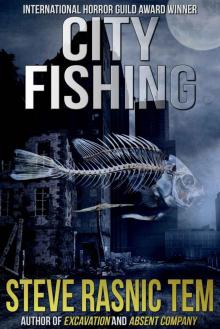 City Fishing
City Fishing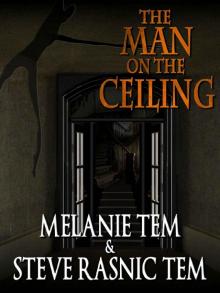 The Man on the Ceiling
The Man on the Ceiling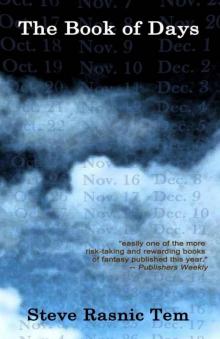 The Book of Days
The Book of Days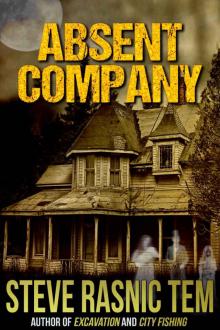 Absent Company
Absent Company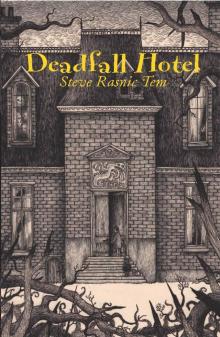 Deadfall Hotel
Deadfall Hotel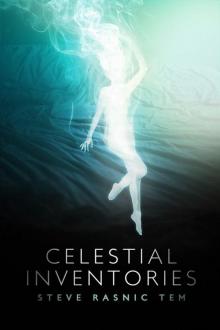 Celestial Inventories
Celestial Inventories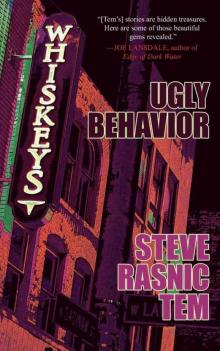 Ugly Behavior
Ugly Behavior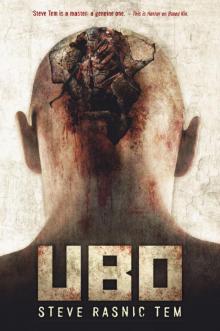 Ubo
Ubo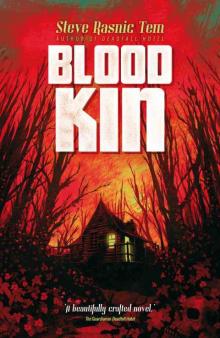 Blood Kin
Blood Kin